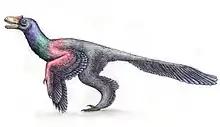Julia Clarke
Julia Allison Clarke is an American paleontologist who is particularly interested in bird evolution and the dinosaurs most closely related to living birds. She works at the University of Texas where she is the John A. Wilson Professor in Vertebrate Paleontology.
Julia Allison Clarke | |
|---|---|
 Presenting in Texas | |
| Nationality | United States of America |
| Occupation | Academic |
| Employer | University of Texas |
| Known for | study of avian dinosaurs |
Life
Clarke's first degree was from Brown University in 1995 where she studied both geobiology and comparative literature. She went on to study at Yale University's Geobiology and Geophysics department where she gained her doctorate in 2002.[1]
Clarke holds the John A. Wilson Professorship in Vertebrate Paleontology at the University of Texas.[2]
Clarke discovered within the rocks of Vega Island in the Antarctic in 1992, Vegavis iaai which was an early relative of ducks and geese in 2005. It is thought to be the only species of modern bird to have lived at the time of the dinosaurs.[3] She studied the voice organ (syrinx) of a fossil originally found in 1992. The findings by her and other researchers was published in the science journal Nature.[4]
Fossils of the ancient bird Inkayacu were first discovered in 2008 on the Pacific coast of Ica, Peru. A nearly complete skeleton was uncovered[5] in the Paracas National Reserve by a team led by Rodolfo Salas and studied by a team led by Clarke. This was the first recovered fossil with feathers attached to it. The feathers were preserved enough such that Liliana D'Alba and Ali J. Altamirano were able to perform analysis of the melanosomes which are responsible for pigment. Until now, without the addition of feathers, there has not been any research conducted on the nanostructure of ancient feathers. Large penguins, including the species Perudyptes devriesi and Icadyptes salasi, had been described from the area the previous year.[6]
In 2016 she speculated that based on her research she felt it was unlikely that dinosaurs roared. She proposed that it was much more likely that they made noises that were similar to those made by a modern pigeon.[7]


In 2018 she was reporting on a small chicken sized dinosaur that was found in China by a farmer. The dinosaur was relatively well preserved and analysis indicates that it had multi-feathers. The creature is not thought to have been able to fly but appears to have been a small carnivore. The feather's purpose may have been insulation whilst the variation in colour is thought to have made the dinosaur attractive to a potential mate. The creature is thought to have a multi coloured crest and this translates to its scientific name which is Caihong juji.[8]
Works include
- The Morphology and Systematic Position of Ichthyornis Marsh and the Phylogenetic Relationships of Basal Ornithurae, 2002[9]
References
- "About". Julia Clarke. Retrieved 2018-08-04.
- "Julia A Clarke | Jackson School of Geosciences | The University of Texas at Austin". www.jsg.utexas.edu. Retrieved 2018-08-04.
- "Oldest fossil of bird's voicebox gives new hint at soundscape of the Cretaceous". Retrieved 2016-10-12.
- "Could Dinosaurs Roar? Fossil Voice Box Hints T. Rex Tweeted". NewsMax.com. Retrieved 2016-10-13.
- Inkayacu at Fossilworks.org
- Clarke, J.A.; Ksepka, D.T.; Stucchi, M.; Urbina, M.; Giannini, N.; Bertelli, S.; Narváez, Y.; Boyd, C.A. (2007). "Paleogene equatorial penguins challenge the proposed relationship between biogeography, diversity, and Cenozoic climate change". Proceedings of the National Academy of Sciences. 104 (28): 11545–11550. doi:10.1073/pnas.0611099104. PMC 1913862. PMID 17601778.
- "We Now Know How Dinosaurs Sounded — And It's Nothing Like 'Jurassic Park'". Mic.com. Retrieved 2018-08-04.
- "This "Rainbow" Dinosaur Found in China Was Probably a Magnet for Mating". Retrieved 2018-08-04.
- Julia Allison Clarke (2002). The Morphology and Systematic Position of Ichthyornis Marsh and the Phylogenetic Relationships of Basal Ornithurae. Yale University.
